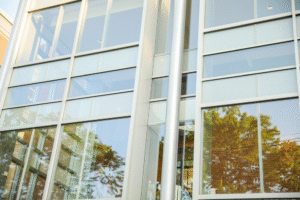
HVAC systems often account for more than 40% of total energy consumption in commercial buildings, making them one of the most significant operational expenses. While mechanical upgrades are common, many projects overlook a critical factor that affects HVAC efficiency: energy-efficient commercial windows.
Windows’ poor thermal performance allows unwanted heat gain or loss, forcing HVAC systems to operate under higher loads and extended runtimes. This leads to increased energy use, faster equipment wear, and higher utility costs.
This article examines how energy-efficient commercial windows reduce pressure on HVAC systems by improving insulation, minimizing air leakage, and stabilizing indoor temperatures. You’ll find practical insights into the technologies behind high-performance windows, financial impacts, and how to select the right solution for your building’s needs.
The relationship between energy-efficient commercial windows and HVAC system performance
HVAC systems are designed to manage internal climate conditions. However, even the most efficient equipment is forced to overcompensate when a building’s envelope fails to insulate properly.
Windows are one of the primary points of thermal transfer in any structure. Poorly specified or outdated window systems allow heat to escape during winter and infiltrate during summer, placing continuous strain on heating and cooling units.
This leads to higher energy consumption, uneven temperature control across zones, accelerated wear on HVAC components, and more frequent maintenance interventions.
In some commercial properties, uncontrolled solar gain through single-pane windows can increase room temperature by several degrees, requiring constant cooling to maintain acceptable indoor conditions.
Energy-efficient commercial windows are engineered to address these issues through advanced glazing, thermal breaks, and airtight sealing systems.
Unlike standard windows, they significantly reduce heat transfer and infiltration, allowing HVAC systems to operate at optimal capacity with less cycling and energy waste. This directly improves the building’s energy performance and helps stabilize the interior comfort level, especially in high-occupancy or large-footprint facilities.
Another critical advantage is load reduction. When minimizing thermal losses, HVAC system sizing can be adjusted accordingly, reducing equipment and operating costs. This is relevant in retrofits or new constructions where right-sizing mechanical systems based on accurate envelope performance translates to real savings.
By reducing thermal exchange at one of the building’s most vulnerable points, energy-efficient commercial windows become a foundational strategy in achieving cost-effective, high-performance HVAC design.
How energy-efficient commercial windows work
The performance of energy-efficient commercial windows depends on how well their components work together to reduce heat transfer, prevent air leakage, and maintain interior comfort.
These systems are engineered to create a physical and thermal barrier between the interior and exterior environments, reducing the load on HVAC systems and increasing energy stability throughout the building.
Here are the main features that define how these energy-efficient commercial windows operate:
Low-E (Low-Emissivity) glass
Low-E coatings are microscopically thin layers of metallic oxide applied to glass surfaces. These coatings reflect infrared radiation while allowing visible light to pass through.
As a result, indoor heat is retained during winter, and solar heat is blocked during summer. This selective control of heat flow improves thermal comfort and reduces HVAC demand.
Double or triple glazing
Insulated glazing units (IGUs) use two or three layers of glass separated by air or gas-filled spaces. These gaps, often filled with inert gases like argon or krypton, reduce conduction and convection between inside and outside air.
This configuration minimizes temperature fluctuations, supporting consistent indoor conditions and lower system runtimes.
Thermal breaks
In aluminum-framed windows, thermal breaks are non-conductive barriers inserted between the interior and exterior sections of the frame. These barriers prevent heat transfer through the metal, increasing the window’s insulating value.
Without thermal breaks, aluminum systems lose energy rapidly, even when paired with high-performance glass.
High-quality sealing and spacers
The seals around window edges and the spacers between glazing layers are responsible for airtightness. Advanced sealing systems prevent infiltration of air, moisture, and pollutants, factors that degrade energy performance and comfort.
Warm-edge spacers reduce thermal bridging around the perimeter of the glazing unit.
These elements allow energy-efficient commercial windows to perform reliably across various climate conditions and building types.
They reduce artificial heating and cooling, provide more stable interior temperatures, and extend the life of mechanical equipment by lowering usage intensity.
Effective window systems rely on the synergy of multiple components, not a single feature. The combination of smart glazing, thermal management, and airtight construction makes energy-efficient commercial windows a practical investment in long-term performance.
Financial benefits of reducing HVAC load

Energy costs in commercial buildings are a long-term operational liability. HVAC systems, often responsible for over 40% of total energy use, represent a major opportunity for optimization.
When energy-efficient commercial windows reduce thermal transfer and air leakage, HVAC equipment cycles less frequently and with lower intensity, leading to measurable savings.
Reduced utility costs
By minimizing heat gain in summer and heat loss in winter, high-performance windows reduce the energy required to maintain target indoor temperatures. Over the course of a year, this can translate into 10–20% lower HVAC-related utility expenses, depending on climate zone and building type. In retrofit projects, payback periods for upgraded window systems often fall within 5 to 7 years.
Lower equipment stress and maintenance
When HVAC systems operate under reduced load, components last longer and require fewer interventions. Less frequent cycling reduces wear on compressors, blowers, and control systems, delaying costly repairs and replacements. Over a 10-year period, buildings with energy-efficient commercial windows can reduce HVAC-related maintenance demands due to lower equipment strain and extended system lifespan, leading to significant cost savings over time.
Tax incentives and certifications
Federal and state programs provide financial incentives for buildings that improve energy performance. These may include tax credits, performance rebates, and accelerated depreciation benefits for energy-efficient upgrades. Installing certified window systems often contributes directly to LEED points or compliance with ENERGY STAR® benchmarking.
Improved asset value and marketability
Buildings with lower operating costs and higher energy efficiency attract tenants, command higher lease rates, and have more substantial resale potential. Windows are a visible, specifiable element that supports green certifications and ESG reporting.
Across the building’s lifecycle, energy-efficient commercial windows deliver returns that extend beyond utility savings. They reduce risk, improve reliability, and support long-term financial performance.
Practical example: Simulated savings from energy-efficient commercial windows
To illustrate the real impact of upgrading to energy-efficient commercial windows, let’s consider a typical mid-size retrofit scenario.
Project scenario
- Building type: 15,000 ft² office building
- Location: Atlanta, GA (hot, humid climate with high cooling loads)
- Baseline: Single-pane aluminum windows from the early 2000s
- Upgrade: Double-pane, argon-filled windows with low-E coatings and thermally broken aluminum frames
Performance improvement
After installation, the building achieved:
- 26% reduction in peak HVAC loads
- Average annual energy savings of 18% on cooling and heating
- More consistent indoor temperature distribution across all zones
- Noticeable decrease in occupant complaints related to comfort and glare
According to the U.S. Department of Energy, buildings in similar climate zones can achieve 20–30% HVAC-related energy savings with high-performance windows—especially when older systems are replaced or supplemented with better glazing and framing.
Financial impact
- Estimated annual energy savings: $6,500
- Estimated HVAC runtime reduction: 22%
- Projected payback period: 6.4 years
- Potential tax incentives: Federal and local rebates totaling up to $4,000
- Improved asset value: Building positioned to meet ENERGY STAR® benchmark thresholds
Additionally, maintenance staff reported fewer temperature complaints and reduced frequency of service calls related to window leaks and drafts, an indirect but valuable gain in operational efficiency.
This simulation shows how energy-efficient commercial windows can translate into long-term financial, operational, and comfort-related gains.
How to choose the right energy-efficient commercial windows for your project
Not all window solutions perform equally. Choosing the right energy-efficient commercial windows requires a careful evaluation of technical specifications, climate demands, building usage, and long-term operational goals.
A poor match between product and project leads to underperformance, even when the windows are labeled as efficient.
Here are the key factors to consider before specifying or purchasing:
Glazing type
Double or triple glazing with inert gas fills (like argon or krypton) reduces thermal transfer. Look for low-emissivity (Low-E) coatings that reflect infrared radiation and minimize solar heat gain without blocking natural light. The choice between double and triple glazing depends on the building’s insulation needs, local climate, and budget constraints.
Frame material
Frames influence energy performance and structural durability. Thermally broken aluminum is a popular choice for balancing strength and insulation. uPVC and fiberglass offer excellent thermal resistance and low maintenance, while composite systems combine structural and thermal benefits for more demanding projects.
Certification labels
Reliable energy-efficient commercial windows carry certification labels that validate their performance. Look for:
- NFRC (National Fenestration Rating Council): Shows U-Factor, SHGC, VT, and air leakage values.
- ENERGY STAR®: Confirms the product meets regional efficiency standards in the U.S.
Always cross-reference product specs with third-party databases. The NFRC Product Directory is the most trusted source for performance verification.
Supplier expertise
Installation quality and product selection depend heavily on the supplier. Work with experienced providers who specialize in commercial-grade performance and offer support in compliance, installation guidance, and warranty-backed systems.
Compatibility with building systems
Confirm that the window system aligns with HVAC load calculations, energy models, and sustainability targets. Mismatches between windows and mechanical design lead to inefficiencies, even when both components are high quality on their own.
Ensure that energy-efficient commercial windows deliver the performance your project demands by combining the right materials, certifications, and partners.
Why Top Notch Remodeling is the right partner for your project

Specifying high-performance window systems is one thing. Installing them correctly and maximizing their real-world performance is another.
Many commercial projects underdeliver on energy goals, not because the installation didn’t follow technical standards or the material choice wasn’t aligned with the building’s demands.
At Top Notch Remodeling, we bridge that gap with precision, experience, and accountability.
We specialize in the supply and installation of energy-efficient commercial windows across a wide range of sectors, including office buildings, retail, healthcare, and education. Our team understands the technical requirements behind performance ratings like U-Factor and SHGC, and how to translate those specs into results on-site.
What sets Top Notch apart:
Certified installers trained in commercial-grade systems
Fluent in code compliance, energy modeling, and LEED-aligned components
Project-based support, from spec review to final walkthrough
On-site discipline, with clean installation, airtight seals, and zero rework
Experience across Georgia, including climate-specific adaptation and local code coordination
Energy-efficient commercial windows as a strategic investment
Reducing HVAC costs in commercial buildings isn’t just a matter of upgrading equipment. It starts with how the building manages heat and airflow at the envelope.
Energy-efficient commercial windows are essential in this strategy, as they minimize thermal loss, reduce system strain, and stabilize interior comfort.
Beyond performance gains, these windows help lower energy bills, extend the life of mechanical systems, and improve asset value. Whether in new construction or retrofit applications, the right solution can support compliance with sustainability benchmarks and certifications.
If you’re evaluating building upgrades or planning a new project, our team at Top Notch can help you specify and install systems tailored to your climate, performance targets, and operational goals.
Contact us today to explore personalized recommendations and turn energy savings into long-term results.



